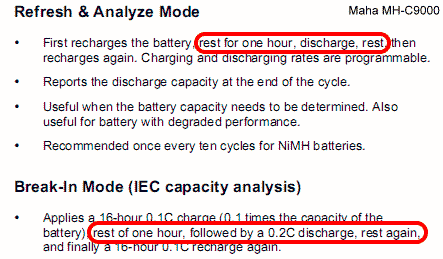 Originally posted by cadmus
Originally posted by cadmus 
Hate to drag this out but:
What physically/chemicaly/redoxily (i made that word up) causes damage if you drop below .9 volts?
Deep discharge (to below 0.9V) is not healthy for the battery -
very deep discharge can damage the battery.
I have never done that - so do not know from first hand experience -
I understand getting hit by a car head on at 90 mph can kill you -
but I've never done that to tell you that from first hand experience.
 Originally posted by cadmus
Originally posted by cadmus 
Also, lets say i had all the time in the world. If i discharged at 100 that kept them at room temp. If heat is our only big fear is there any reason to rest them when draining at such a low speed? (that was the logic behind my hot hot is too hot questions)
If you had all the time in the world discharging at 100mA for 15.2 hours -
probably can save you the suggested 1 hour wait
when discharging at 400mA for 3.8 hours
TOTAL time saving = oh, wait it's negative .....
at
-10.4hours.
Good thinking Batman!

From the
Maha C9000 manual:

 Originally posted by cadmus
Originally posted by cadmus 
As a side note i felt no observable temperature change at 100, 250 or 350.
Have you actually
fully discharged sets at 100, 250 and 350mA to be able to say that?
Or are you just switching the discharge currents and feeling for the temperatures?
It's the temperatures toward the end of discharge that matters -
if they are warm - then one ought to wait a while before charging -
really, is it that hard to accept?
That's somewhat like telling the difference between 30 and 40mpg cars -
just by starting the cars in the driveway......


Last edited by UnknownVT; 06-05-2011 at 12:11 AM.


 Similar Threads
Similar Threads 











 Post #32 by UnknownVT
Post #32 by UnknownVT








